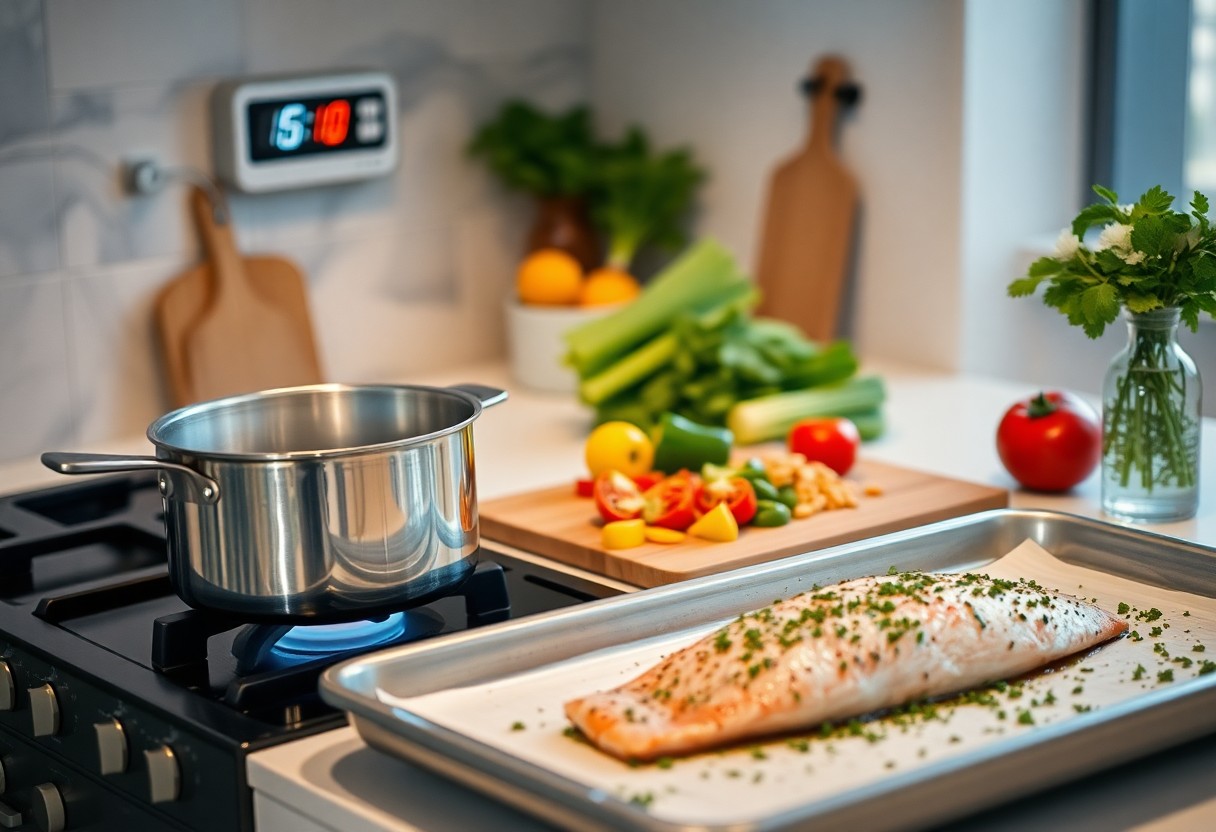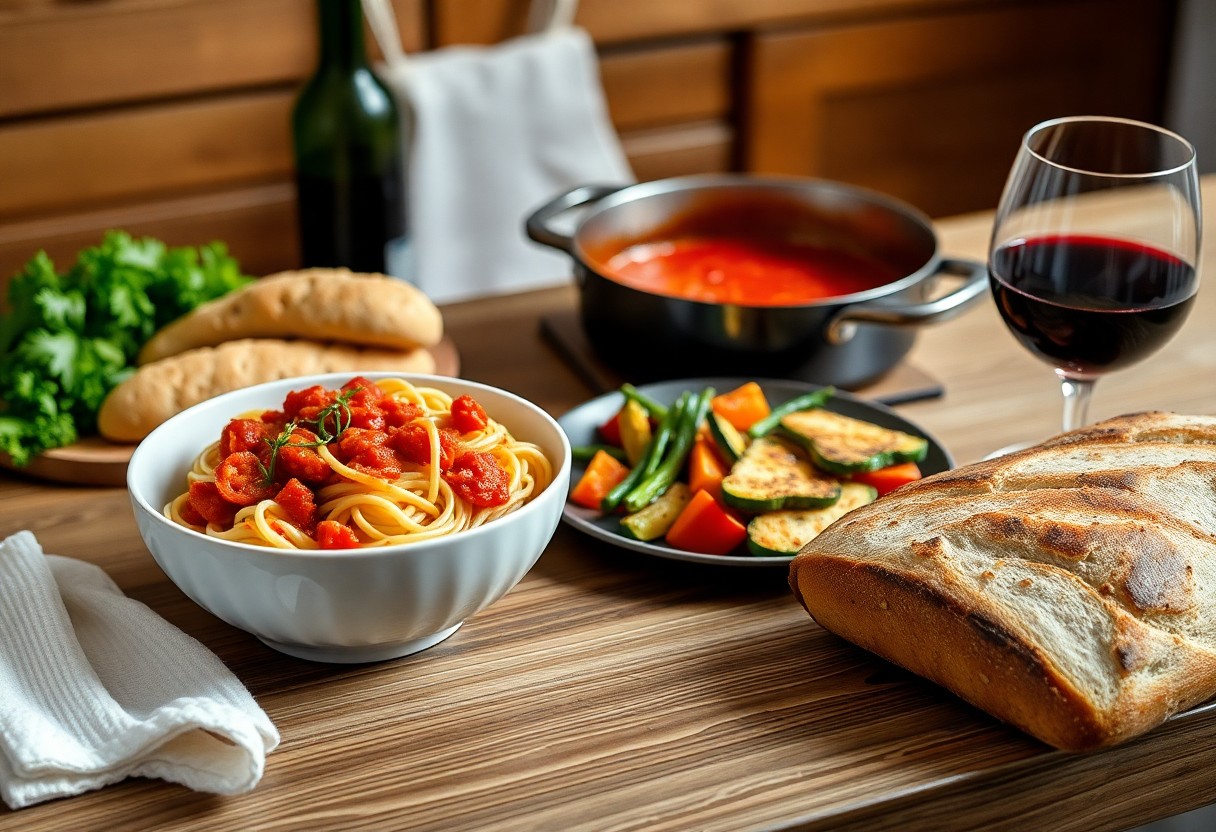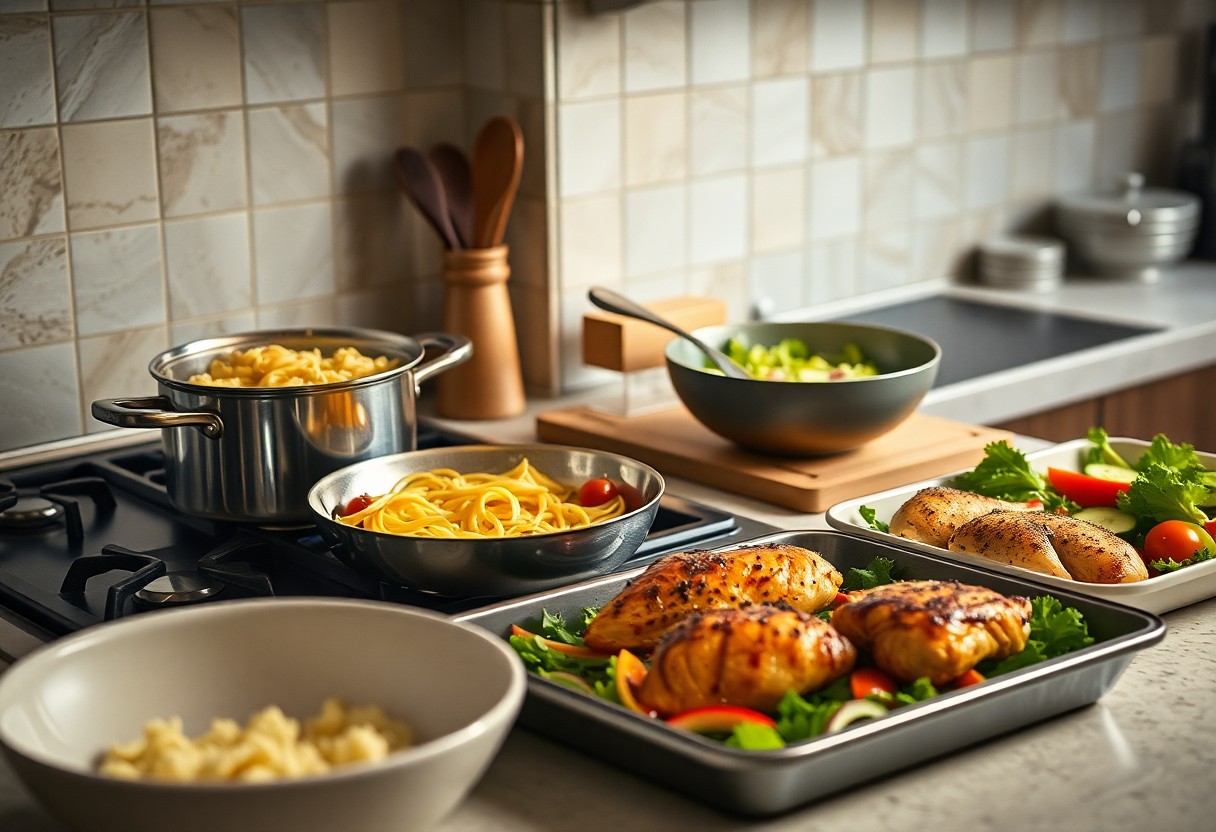Most home cooks underestimate how efficiently they can prepare a complete dinner while waiting for pasta to boil. By mastering the art of multitasking and utilizing simple ingredients, you can create a delicious full meal that not only saves time but also satisfies your hunger. In this guide, you’ll discover effective strategies that allow you to slice, sauté, and season alongside the boiling pasta, ensuring that every element of your dinner is ready to enjoy when the clock runs out. Get ready to impress yourself and your loved ones!
Key Takeaways:
- Prepare ingredients in advance: Chop vegetables, marinate proteins, and measure out spices while the pasta is cooking to save time.
- Utilize multitasking techniques: Use the boiling pasta as an opportunity to cook side dishes or sauces simultaneously on the stovetop or in the oven.
- Choose quick-cooking recipes: Select dishes that have shorter cooking times, such as stir-fries or salads, which complement the pasta conveniently.

Maximizing Efficiency in Your Kitchen
Streamlining your cooking process makes a significant difference in meal prep time. Efficient kitchens are rooted in organization and the smart use of tools, allowing you to create cohesive meals without unnecessary delays. By adopting a few strategic practices, you can turn what typically takes over an hour into a seamless operation that fits within the brief time it takes to boil pasta.
Organizing Your Workspace: The Key to Speed
A clutter-free workspace can drastically enhance your cooking speed. Start by grouping similar items together, such as spices, utensils, and cutting boards, within arm’s reach. Each ingredient for your dish should be easily accessible, allowing you to minimize time spent searching through cabinets. Consider using open shelving or labeled containers for quick identification and access, which facilitates a smooth workflow.
Essential Tools for Optimizing Cooking Time
Your choice of kitchen tools can significantly impact how quickly you prepare meals. Invest in a quality chef’s knife, non-stick pans, and a food processor to accelerate chopping and mixing. Tools like a pressure cooker or slow cooker can also help you multitask, creating more complex dishes in tandem with your pasta with minimal supervision needed.
For instance, a food processor can chop vegetables in a fraction of the time it would take by hand, and a pressure cooker can tenderize meats and cook grains quickly, making them great companions to your boiling pasta. Utilizing equipment that speeds up preparation, like an immersion blender for sauces or a microwave for reheating components, allows you to keep everything moving smoothly without sacrificing quality. Embrace these crucials to maximize your efficiency and transform your cooking experience.

Harmonizing Flavors: What to Prepare Alongside Pasta
Pairing your pasta with complementary sides not only enhances the overall flavor of your meal but also creates a visually appealing plate. Strive for a balance of textures and tastes—switching things up between creamy, crunchy, and savory elements. Consider serving a crisp salad with vinaigrette, garlic bread with a hint of parmesan, or sautéed vegetables seasoned with Italian herbs. These accompaniments can elevate your pasta dish, making it a full dinner while ensuring that cooking overlaps seamlessly with the pasta’s boil time.
Selecting Complementary Dishes for a Balanced Meal
Choosing the right side dishes can transform your pasta night into a delightful culinary experience. Think of adding a fresh arugula salad topped with cherry tomatoes and balsamic dressing to contrast the richness of a creamy pasta. Grilled vegetables seasoned with olive oil provide a beautiful color and nutritional balance while adding a smoky flavor that complements any sauce. Aim for a combination that harmonizes well with your pasta’s primary sauce.
Speedy Cooking Techniques for Side Dishes
Utilizing quick cooking methods can help you prepare side dishes that align perfectly with your pasta. Techniques like sautéing, steaming, and microwaving are game changers. For instance, throw chopped vegetables in a hot pan with a drizzle of olive oil and a sprinkle of salt and pepper—within minutes, you’ll have a vibrant side dish. Similarly, steaming green beans or asparagus takes just a few minutes while keeping them crisp and nutritious. Using these methods allows you to multitask effectively and serve a delicious, balanced meal.
Simultaneous Cooking Strategies
To achieve the feat of cooking an entire dinner while your pasta boils, streamlining your tasks is key. Start by identifying all components of your meal, including proteins, vegetables, and sauces. Organize them into a logical sequence that allows multiple elements to cook in tandem. This strategic planning not only maximizes efficiency but also enhances the overall flavor profile, as the aromas and tastes combine beautifully during cooking.
Timing Your Pasta for Optimal Coordination
Align your pasta cooking time with the preparation of other dishes. Begin boiling water for your pasta while you sauté vegetables or start cooking protein. This way, your pasta will be al dente and ready to be combined with the other elements just as they finish cooking, ensuring everything is hot and fresh at serving time.
Multi-Tasking: Managing Several Pots and Pans
Juggling multiple pots and pans can seem daunting, but with a bit of practice, it becomes second nature. Prioritize smaller, faster-cooking items like vegetables or sauces that can complement your pasta. For instance, while your main protein is on a separate burner, a quick sauté of seasonal greens in a skillet can be done simultaneously. Keep a close eye on each cooking vessel, stirring or adjusting the heat as needed to avoid any overcooking.
Effective multi-tasking relies on a clear visual layout of your workspace. Place sauces or side dishes in easy reach as you manage the pasta boiling on the stove. Utilizing timers can be a great ally, reminding you when to check each item. For example, if you know your pasta takes 10 minutes, set reminders for the protein and vegetables to ensure they finish around the same time, creating a perfectly timed dinner. Utilizing a pot divider can also help you further streamline, allowing you to cook multiple ingredients in one pot, like pasta and a sauce, cutting down on clean-up time post-meal.
The Art of Flavor Infusion: Quick Sauces and Seasoning
Mastering the art of flavor infusion allows you to elevate your pasta dishes with just a few quick sauces and seasonings. With some strategic work, you’ll find that transforming a basic dish into a culinary delight is not just possible, but can be done in mere minutes. Think fresh herbs, zesty citrus, and simple pantry staples that marry together to create an explosion of flavor, all while your pasta simmers. Your goal is to employ these quick techniques to enhance your meal, giving it layers and depth without extending your cooking time.
Building Depth in Flavor with Minimal Ingredients
Creating depth in your dishes doesn’t have to involve a long list of ingredients. Focus on a handful of quality items, like aromatic garlic, robust olive oil, and fresh herbs, that can quickly transform any dish. For instance, sautéing minced garlic in olive oil brings a fragrant base, while a splash of balsamic vinegar can add acidity and brightness. By selecting high-quality components, you can create a well-rounded flavor profile without the fuss.
Quick Sauces: The Essential ‘Go-To’ Recipes
Having a set of quick sauces at your fingertips makes cooking a full meal alongside pasta a breeze. Classic recipes like a garlic and olive oil sauce, a quick marinara, or even a simple lemon-butter sauce can be prepared within minutes. Just melt butter, mix in lemon juice, and toss in herbs to create a mouthwatering accompaniment for your pasta. Experiment with flavor combinations that suit your taste, and make them your all-time favorites.
For example, a simple garlic and olive oil sauce can be made by sautéing minced garlic in olive oil until fragrant, then tossing in your cooked pasta along with some fresh parsley, salt, and pepper. If you’re in the mood for something creamy, whisk together sour cream or Greek yogurt with fresh herbs and a squeeze of lemon juice for a deliciously tangy sauce that takes only seconds to prepare. With these crucial ‘go-to’ quick sauces, you’ll not only maximize flavor but also streamline your cooking process. Keep these recipes in your back pocket to complement any pasta dish and impress your dinner guests!
Plating and Presentation: Elevating a Speedy Meal
As you plate your speedy meal, focus not just on the flavors but also on the visual appeal. A beautifully arranged plate can elevate your dish, making it feel more gourmet and satisfying. Start by layering your components thoughtfully, using the height and colors of the ingredients to create an inviting presentation. A sprinkle of fresh herbs or a drizzle of sauce can transform a simple dish into a culinary masterpiece in seconds.
Visual Appeal: Techniques for Stunning Presentation
Creating visual appeal starts with choosing the right plate; contrasting colors between the dish and the plate enhance the presentation. Utilize shapes, like stacking or fanning ingredients, to add dimension. For instance, arrange vegetables like a fan and place your protein on top to create an eye-catching focal point. Colors matter too; vibrant vegetables can brighten your dish, making it more appealing.
Final Touches: Garnishes and Enhancements
These finishing touches can significantly elevate your meal. Edible flowers, fresh herbs, and citrus zest can add a pop of color and a hint of flavor that enhances the overall experience. Consider a sprinkle of parmesan or a few drops of specialty oils for added richness and aroma.
Enhancing your dish with garnishes goes beyond aesthetics; it adds depth of flavor and sophistication. Fresh herbs like parsley or basil not only complement savory dishes but also contrast beautifully against starches and proteins. If you’re serving pasta, a light drizzle of extra virgin olive oil or truffle oil can enrich the dish while providing an aromatic finish. A few toasted nuts, such as pine nuts or walnuts, can provide texture and unexpected crunch. Elevate your presentation by placing garnishes thoughtfully, such as atop the protein or around the plate’s edge, guiding your guest’s eye while inviting them to indulge in your stunning creation.
Summing up
Presently, you can transform your dinner routine by maximizing the time it takes for pasta to boil. By prepping ingredients and choosing simple, quick-cooking recipes for your main dish and sides, you can create a full meal in just minutes. Focus on dishes that complement your pasta, utilize seasonal ingredients, and employ efficient cooking methods. This not only saves time but also enhances your culinary skills, allowing you to enjoy delicious home-cooked meals more often.
Q: What types of dishes can I prepare while my pasta is boiling?
A: You can prepare a variety of quick and complementary dishes while your pasta is boiling. Consider sautéing vegetables, making a simple salad, or even cooking a protein like chicken or shrimp. A stir-fry or a light sauce can also be ready in the time it takes for your pasta to cook. The key is to choose recipes that require minimal cooking time and can be easily timed with the pasta. For example, if your pasta takes 10 minutes to boil, focus on recipes that can be completed within that timeframe.
Q: How do I manage my time effectively to cook everything in sync?
A: Start by organizing your cooking tasks based on the time they take to prepare. Begin by putting the pasta on to boil first since that takes the longest. While it cooks, you can chop vegetables, prepare sauces, or season proteins. Use timers to keep track of how much time is left for the pasta and each accompanying dish. Also, make use of multi-tasking; for example, sauté vegetables in the same pan you will use for sauce to maximize efficiency and flavor. Planning your tasks ahead will help you stay on track and ensure everything finishes cooking around the same time.
Q: What tips can enhance the flavor of my dishes while cooking them quickly?
A: Enhance flavors by using fresh herbs, garlic, and spices, which can elevate the taste even when cooking quickly. Simply sauté garlic in olive oil for a couple of minutes before adding vegetables or proteins for added depth. Consider using premade sauces or condiments that can be added at the last minute, such as pesto, soy sauce, or vinaigrettes. Additionally, cooking with high-quality ingredients, such as fresh vegetables and good olive oil, will significantly improve the taste of your dishes without needing extra cooking time.
